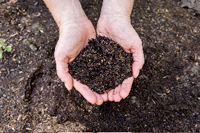Molly Ferrell

Molly Ferrell was formally a UC Davis student who was TA for a biology class before taking a full time job at the Conservancy. She has a good sense of humor and is very enthusiastic about the wildlife in Cache Creek. She was interviewed on location at the Cache Creek Nature Preserve.
Could you describe your job and what you do for the Conservancy?
My job is Habitat Restoration Manager and that means I do restoration of habitats along the creek.
Why is this place important to you, or why is the Preserve as a whole important to you?
This place is important to me because it’s actually an interesting point area for a bunch of different habitats. It is riparian, it is oak woodlands—the Dunnigan Hills area ends here—and it’s grasslands and it is wetlands. Even though it is very small, 130 acres, it is very diverse. I spend a lot of time on the creek, and Cache Creek is one of the most dynamic streams in the country. It goes from 0 cfs [cubic feet per second] to sixty-five thousand cfs in just a short period of time and that makes it very dynamic. So it can be very dry and gravelly in the summer and really rushing waters in the winter.
Could you tell me about the invasive plants that were planted here?
Yes, ones that were planted years ago—tamarisk and arundo—to actually prevent erosion on the creek are the ones that are very large and have ended up dominating much of the creek. I was actually hired sort of post-control of those weeds and I was hired to do restoration in lieu of the control.
How are they doing now? I mean, are they still a big problem for you guys today?
There are tons of invasive weeds. The problem is not that [those two are returning]. You know, even though John Watson did a great job in taking care of those weeds, we have a number of new invasive species that have come in. So our problems are vast in terms of the control of invasive species.
Have the invasive species been a problem for you?
Yes, the invasive species are my primary object because our riparian system is innately weedy. That is because weeds are transported by water downstream. Cache Creek is this long geographic thing that annual flooding really changes from year to year, so oftentimes you get weed seed from upstream or parts of plants that start new colonies. There’s just a huge number of weed species that we have that are sort of constant.
Can you tell me about an experience that really stands out to you?
Well I have to say that part of what we are allowed to do here on the Preserve is use fire as a way to control invasive species. It is beneficial to the natives often because most of them are adapted to fire, especially in the oak woodlands, the riparian forest. Part of it is adapted, not all of it. Cottonwood trees burn really easily, so they don’t regenerate after being on fire like an oak would, or sedges and other different kinds of plants. Fire techniques were used by the native Indian tribes. Don Hankins did research on that and had a research project here. So I’ve been working on that along with spraying and burning different areas of the Preserve and having success with that.
Can you tell me a favorite experience you have had here on the Nature Preserve?
I think some of my favorite experiences working here are just that I get to work here and get outside everyday and see this wonderful place and be in it and it is beautiful. I get to see the plants, see the seasons change, see all the native bees and birds and wildlife—and here comes a duck!—and we have bobcats and there is a mountain lion roaming around and it’s just exciting and one of the things I really enjoy. I used to TA for the habitat conservation restoration class at UC Davis. Since working here, I stopped TA-ing, but the class still comes up here to do their lab projects every winter. They just finished last week. It is just really fun to have these students come and have field experience and learn, you know, work with different types of equipment and learn how to monitor plants. It’s often the wildlife students, so they don’t have plant experience, so it’s fun!
To download the audio, right click on the audio link above and scroll to "Save link as . . ." and choose the directory where you want to store the mp3. In Windows, you may have to use Control + S to select the link.